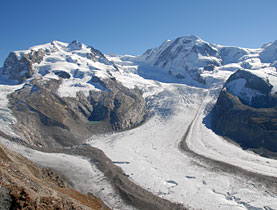
Valais ice monsters surrender human remains

The steady drip-drip-drip of melting glaciers in the southern canton of Valais is having unexpected, often macabre, results: an increasing emergence of human remains.
At the end of July a mitten, a 40-year-old camera and a human bone were recovered in one location on the spectacular Gorner glacier above Zermatt.
According to Patrick Rovina, a scientific expert with the Valais cantonal police, such discoveries are a growing phenomenon.
“Over recent years with the retreat of the glaciers automatically things inside start appearing,” he told swissinfo.ch. “Last year we had five cases with human bones like this one.”
Bruno Jelk, head of the rescue services at Air Zermatt, confirmed this trend.
“People tell us they have found bones, old skis, clothes and other objects,” he explained, adding that full skeletons have previously been found near the Matterhorn or on the Gorner glacier.
The Gorner glacier shrank by 290 metres between 2007 and 2008, according to scientists at the Federal Institute of Technology in Zurich.
300 missing
Bones and related objects are found both in high glacier regions as well as lower down in rivers and streams flowing into the Rhône Valley.
Since 1926 some 300 people have disappeared and are officially unaccounted for in canton Valais.
In the upper Valais region disappearances mainly concern the Zermatt and Saas Fee regions, which are extremely popular with tourists and local visitors. In winter some two million people go skiing in Zermatt and 425,000 climb its slopes in summer.
Human remains have also turned up at Evolène, Sanetsch, Trient and Grand-Combin in the lower Valais region.
All three objects discovered at the end of July were found together at 2,500m on the 14-kilometre Gorner glacier on the west side of the Monte Rosa Massif.
“But it doesn’t mean they belong to the same person as the bone is quite old. It’s possible that it travelled on its own to the other objects,” said Rovina.
Oldest cases
In January 2009 the remains of two women were discovered at Viège and at Tourtemagne in the Rhône Valley. They belonged to a 72-year-old German tourist who had disappeared in 2001 and a 68-year-old local from Unterems who had vanished in 1973.
But the oldest case the police investigator has dealt with was a father and son who disappeared in 1967.
Bones, including a leg, and a pair of shoes were spat out of a glacier over a period of several months in 2007 and discovered by tourists.
“The glaciers are in movement. Sometimes you find one part and later 50-100 metres lower down you come across another body part,” he explained.
DNA technology
To get to the bottom of these high-altitude disappearances, local police are helped by modern DNA identification technology.
The Valais investigators work in close collaboration with the Institute of Forensic Medicine at Bern University and Lausanne University’s School of Criminal Justice.
The success of a case often depends on how exposed a bone has been to humidity and sunlight, say the experts.
Whenever a new bone is found under a glacier, the police carefully wrap and store it at optimal conditions to prevent the DNA from decomposing before it is transferred to one of the two centres.
The Valais force also has a huge storeroom in Brig full of old skiing and climbing material found on the slopes, such as boots, skis, clothing, ice axes, crampons, rucksacks and other paraphernalia, which has been carefully catalogued and one day could be useful when solving the case of a missing person.
The old mitten found on the Gorner may well reveal some hidden secrets, says Rovina.
“We’ll have to see if there is something inside, perhaps a piece of skin. We need to dry it out thoroughly and then analyse it,” he said.
Simon Bradley, swissinfo.ch
Glaciers are large masses of snow, ice and rock debris that accumulate in great quantities and begin to flow outwards and downwards under the pressure of their own weight.
They are formed when yearly snowfall in a region far exceeds the amount of snow and ice that melts in a given summer.
In Switzerland, glaciers play an important role as water reservoirs for hydro-power production (generating 50% of the country’s electricity). They are also considered an important tourist attraction.
Glaciers around the globe have been shrinking significantly since the second half of the 19th century, according to the Swiss-based World Glacier Monitoring Service.
It said there were strong glacier retreats in the 1940s, stable or growing conditions around the 1970s, and again increasing rates of ice loss since the mid 1980s.
Under current climate scenarios presented by the Intergovernmental Panel on Climate Change (IPCC), the ongoing trend of worldwide and rapid, if not accelerating, glacier shrinkage…may lead to the deglaciation of large parts of many mountain ranges by the end of the 21st century.
Switzerland’s glaciers lost 18% of their surface between 1985 and 2000. In the Alps, the average loss has been 22%. Swiss glaciers are melting more slowly because most are at high altitude.
Meltdown first affects smaller glaciers – which represent 18% of total glacier surface but nearly half the losses incurred – according to a 2004 study from Zurich University.

In compliance with the JTI standards
More: SWI swissinfo.ch certified by the Journalism Trust Initiative





























You can find an overview of ongoing debates with our journalists here . Please join us!
If you want to start a conversation about a topic raised in this article or want to report factual errors, email us at english@swissinfo.ch.